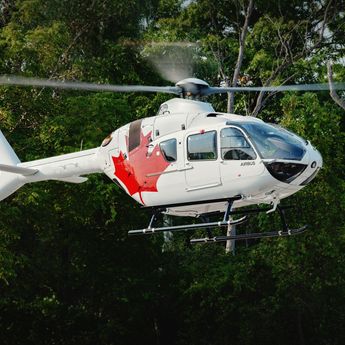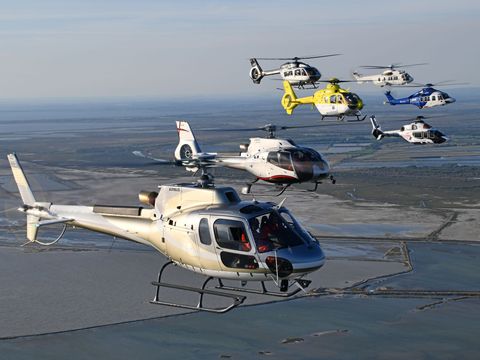Introduction
The three-tonne-class H135 rotorcraft is the perfect platform for military pilot training – from evolving aviators’ skills to preparing them for complex mission scenarios.
The helicopter has also been selected by the Spanish Navy to perform demanding missions in naval environments. By the end of 2024, the first H135 helicopters of the Spanish Navy will achieve Initial Operational Capability (IOC).
In addition to providing a sophisticated helicopter platform with advanced avionics and the ability to train in various configurations, the H135 is easy to maintain. More than 1,400 of these twin-engine helicopters are in service worldwide, accumulating over seven million flight hours to date.

The new-generation trainer
Military rotorcraft are increasingly equipped with the latest technologies, digital systems and advanced mission equipment. In meeting the requirements for training aircrew on these helicopters, a modern platform is mandatory. Only the H135 meets such training requirements at a high level of simplicity, reliability and safety – while also benefiting from low operating costs.
The H135’s quick role-change capability, coupled with unmatched cabin versatility, enables crew training in different mission configurations – including utility, surveillance, medical evacuation and other specialised applications.
With the Airbus-developed Helionix® avionics, the H135 integrates an advanced cockpit and the most modern human-machine interface. It enables full instrument flight rules (IFR) capabilities for operations in instrument meteorological conditions (IMC).

Enhancing naval capabilities
The Spanish Navy officially welcomed its first Airbus H135 helicopter in October 2023. The versatile H135 will support a new era of operational flexibility. The primary mission of these helicopters will encompass training and utility operations with the ambition to significantly enhance the Spanish Navy’s capabilities.
For naval operations this aircraft can fulfil a wide range of roles, such as transportation and reconnaissance, and is well-suited for operating in both diverse and challenging environments, such as high sea and hot climates. The arrival of an H135 fleet is a significant step toward more versatility and readiness in operational environments.
The Spanish Navy’s H135 “Nival” in action during qualification campaign
A stepping-stone to advanced helicopters
As a high-performance light-twin rotorcraft, the H135 provides student pilots with an easy transition to larger helicopters.
Training programmes in IFR flight, tactical manoeuvres, night vision goggles and crew resource management can be downloaded onto the H135 for cost-efficient training – thereby requiring only a type-specific familiarisation course for pilots when they transition to more advanced rotorcraft.
The H135 is the quietest helicopter in its class, with certified sound levels well below the ICAO limit – offering added value for recurrent training operations and extended-duration missions.
Today, the H135 is deployed for military training in countries that include Australia, Germany, Japan, Switzerland and the UK – among others.
Elevated performance
The H135’s Helionix® avionics offer undisputed superiority for flight envelope protection, pilot assistance and situational awareness – resulting in unprecedented safety levels. The avionics’ open architecture and modular design incorporate embedded functions, as well as the capability for the further integration of additional mission requirements.
Helionix® also is available on civil and military versions of Airbus’ H145, H175 and H160 rotorcraft, making the H135 a perfect trainer for these helicopter types.
The H135’s plug-and-play design philosophy – in which optional equipment such as hoists or ventilators can be swapped out with equipment from other helicopters – enables the H135 to undergo a quick makeover for service in passenger transportation, disaster relief, search and rescue, VIP airlift and other missions.
Extensive fleet experience and a high level of product maturity enable the H135's maintenance scheme to be “trimmed to perfection” – delivering H135 operators with extended intervals for the scheduled inspections, excellent maintainability, high time before overhaul (TBO) times, along with outstanding reliability and availability.
Safety first
With all-composite rotor blades and Airbus’ signature Fenestron anti-torque shrouded tail rotor system, the H135 can safely operate in confined areas. The simplified main rotor design ensures a controlled environment for precision flying, while also contributing to the H135’s low maintenance costs.
Additionally, there is no compromise for aircrew protection with the latest CS27/FAR27 crashworthiness standards – including an energy-absorbing fuselage and seats, as well as crash-resistant fuel cells. Safety is further enhanced through hydraulic, electric and lubrication redundancies.
The H135’s state-of-the-art cockpit enables an unrestricted field of view, while the pilot workload is eased through an unmatched Human Machine Interface (HMI) and an Anti-Resonance Isolation System (ARIS).
The latest on the H135
In the spotlight
-
 Press releases Helicopters
Press releases HelicoptersGlobal Medical Response orders 28 Airbus helicopters in fleet expansion
Global Medical Response has placed an order for 28 Airbus helicopters, including six H125s, five H130s, 14 H135s and three H145s. -
 Press releases Helicopters
Press releases HelicoptersAirbus signs historic contract to provide 19 H135 military training helicopters to…
-
 Stories Helicopters
Stories HelicoptersThe upsides of upsizing: a new UK HQ for Airbus Helicopters
-
 Stories Helicopters
Stories HelicoptersChile’s Carabineros: Ready for every call
-
 Stories Helicopters
Stories HelicoptersUK HEMS - a charitable success story







